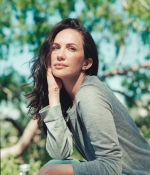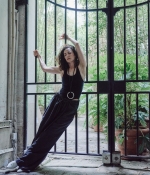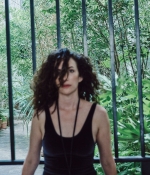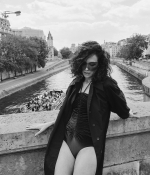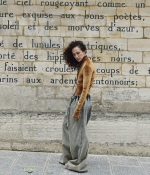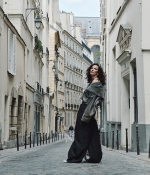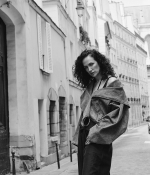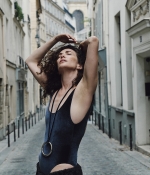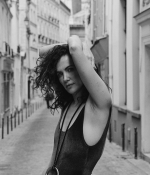Aced Magazine – Kate Siegel & director Mike Flanagan on HUSH
Best known for her portrayal of Marisol in the spine tingler Oculus and for Jennifer in The Curse of the Black Dahlia, Kate Siegel is an accomplished actress with an impressive body of work. In Hush, Siegel teams up with Oculus writer/director Mike Flanagan to create the terrifying thriller of a deaf woman stalked by a psychotic killer in a woods-secluded home. In this one-on-one interview, Siegel and Flanagan reveal the insights and challenges they faced in bringing Hush to life.
How was the collaboration between you two? Did you outline together? Write the script together?
Kate Siegel: It was deeply collaborative. Mike would go outside our house and try to break in and I’d have to find a way to escape from him. We’d try out these things in real time, so we nailed down what to do on both ends—Maddie on the inside and the Killer on the outside. When we found something that worked, we’d stop and write down what we liked. After we turned in our first draft, we got some notes from our producer. We then took the script to the Stanley Hotel in Colorado—in room 217 in honor of Stephen King’s The Shining. We went down to the bar and hammered out the second draft.
There’s not much dialog, but the sound added so much to the film’s tension and terror. Can you go into the sound design of the film?
Kate: Jonathan Wales—our sound mixer—is an amazing genius who created a soundscape like nothing we’ve ever heard. Even the silences you experience have about 50 different sound levels.
Mike: It was clear going in that the sound design would be crucial for this movie. It was expensively more complex than anything else I’ve worked on. Typically, when you’re doing sound design, you want it to advance the story without calling attention to itself. Good sound design is meant to be processed almost subconsciously in most movies. For Hush, it was the opposite. Sound would be front and center, which meant that noises you typically want to bury in a sound mix—like footsteps, wind or crickets—would be the only thing the audience could hold onto sonically. So we had stretches of the movie where we wanted to imply what it’s like to be deaf. The first instinct would be to simply pull the sound out. But if you do that, all you hear is popcorn being chewed or coughing, and that takes people out of the movie. So our silence from Maddie’s perspective was actually an incredibly dense soundscape meant to give the impression of silence. Some of the noises we used were ultrasound, heartbeats, and the slowed down sound of glacial ice cracking.
How did you go about casting Maddie’s tormentor? His icy demeanor and explosive anger turned Hush into a cover-your-eyes nail biter.
Mike: We knew that the mask wouldn’t be on the Killer’s face too long. We wanted to see the human being behind the mask. When the mask came off, it was really important that the person underneath be someone who you wouldn’t think was capable of this. It had to be someone you’d bump into at the supermarket or street.
Kate: And John Gallagher Jr. was a tremendous talent. I was thrilled with his theater work. He was someone you’d never expect as a Killer.
Mike: He’d never done anything like this before. He could always pass as the nice guy. So he was really playing against type. When his name came up for the role, we said, that’s the guy.
There’s a saying among soldiers who finally find the courage to fight to survive: “The wolf rises.” What did you draw from to communicate that emotion without words?
Kate: The two years before Hush were very difficult times in my life. So when I approached Maddie, I saw her deafness and muteness as a characteristic. As someone who’s neither deaf nor mute, the only thing I could relate to was the internal struggle of wanting to be heard. I wanted to tap into that very human, very female feeling that the world around you won’t listen. And they won’t let you speak. At a certain point, you say, screw this, I can’t live the rest of my life not being heard. I was feeling that a lot leading up to the production of Hush. So when the time came to “awaken the wolf and let it rise,” I tapped into that feeling of needing to be heard by those around me.
Mike: There’s a moment in the movie where she kind of rises off the ground, which illustrates your analogy beautifully. We basically shot the movie in chronological order. So by the time we got to that scene, Kate had been working 16 weeks, all nighttime shoots, working in the cold woods of Alabama.
Kate: Unable to make any noise.
Mike: When we filmed that sequence, Kate was already very much in that mindset.
Kate: There was a great trust between Mike and I. I would turn to him after takes, and I would be so angry and uncomfortable that I couldn’t be myself. And Mike would look at me and say, you’re in the exact right place. One thing I like about Maddie: there was this deep well of strength that she captured for the first time and her joy at finding that inside herself.
What were your favorite scenes?
Kate: The scene with Samantha Sloyan, a warm, giving, open actress who played my neighbor. The dialog scene with her was such a joy. It’s a turn from the rest of the film, and it creates a sense of who Maddie really is and how she interacts with people around her.
March 30, 2016
Source
by Alex Kecskes
